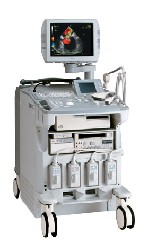Medical Ultrasound Imaging
Wednesday, 8 May 2024
'Sound Beam' Searchterm 'Sound Beam' found in 74 articles 1 term [ • ] - 73 definitions [• ] Result Pages : • Sound Beam
(short for ultrasound beam) The sound beam is the confined, directional beam of ultrasound traveling as a longitudinal wave from the transducer face into the propagation medium. The near field and the far field are two separate regions along the beam. Sound beams are either steered mechanically or electrically. Both rapidly sweep sound waves through tissues. See also Sheer Wave, Beam Vessel Angle, Beam Steering, and Huygens Principle. •
A zone is a focal region of the ultrasound beam. An ultrasound beam can be directed and focused at a transmit focal zone position. The axial length of the transmit focal zone is a function of the width of the transmit aperture. The field to be imaged is deepened by focusing the transmit energy at progressively deeper points in the body, caused by the beam properties. Typically, multiple zones are used. The main reason for multiple zones is that the transmit energy needs to be greater for points that are deeper in the body, because of the signal's attenuation as it travels into the body. Beam zones:
•
Near zone - the region of a sound beam in which the beam diameter decreases as the distance from the transducer increases (Fresnel zone).
•
Focal zone - the region where the beam diameter is most concentrated giving the greatest degree of focus.
•
Far zone - the region where the beam diameter increases as the distance from the transducer increases (Fraunhofer zone).
The tightest focus and the narrowest beam widths for most conventional transducers are in the mid-field within the zone where the acoustic lens is focused. The ultrasound beam is less well focused and, therefore, wider in the near and far fields which are superficial and deep to the elevation plane focal zone. The beam width is greater in the near and far fields, making lesions in these locations more subject to a partial volume artifact. See also Derated Quantity. •  From ALOKA Co., Ltd.;
From ALOKA Co., Ltd.;'A Platform for Pure Harmonic Detection Harmonic Echo™ technology constructs images using second harmonic components, which contain far less artifacts and noise than fundamental-frequency components. Pure Harmonic Detection is a technology to transmit distortion-free, fundamental-frequency ultrasound beams. And when the fundamental-frequency ultrasound beam is a pure sinusoidal wave, both the fundamental-frequency image and the Harmonic Echo™ image are much clearer with less noise. This technology is especially effective for obese patients and in a variety technically difficult scanning conditions.' •
Also called B-mode echography, B-mode sonography, 2D-mode, and sonogram. B-mode ultrasound (Brightness-mode) is the display of a 2D-map of B-mode data, currently the most common form of ultrasound imaging. The development from A-mode to B-mode is that the ultrasound signal is used to produce various points whose brightness depends on the amplitude instead of the spiking vertical movements in the A-mode. Sweeping a narrow ultrasound beam through the area being examined while transmitting pulses and detecting echoes along closely spaced scan lines produces B-scan images. The vertical position of each bright dot is determined by the time delay from pulse transmission to return of the echo, and the horizontal position by the location of the receiving transducer element. To generate a rapid series of individual 2D images that show motion, the ultrasound beam is swept repeatedly. The returning sound pulses in B-mode have different shades of darkness depending on their intensities. The varying shades of gray reflect variations in the texture of internal organs. This form of display (solid areas appear white and fluid areas appear black) is also called gray scale. Different types of displayed B-mode images are: The probe movement can be performed manual (compound and static B-scanner) or automatic (real-time scanner). The image reconstruction can be parallel or sector type. See also B-Scan, 4B-Mode, and Harmonic B-Mode Imaging. Further Reading: News & More:
•
The dimension of the ultrasound beam and the transducer array are the origin of the beam width artifact or volume averaging artifact. When the ultrasound beam is wider than the diameter of the lesion being scanned, normal tissues which lie immediately adjacent to the lesion arc included within the beam width, and their echotexture is averaged in with that of the lesion. Thus, what appears to be the echogenicity of the lesion is really that of the lesion plus the averaged normal tissues. Because of volume averaging, cystic lesions may falsely appear to be solid, and some subtle solid lesions may become impossible to distinguish from surrounding normal tissue and, therefore, not identified at all. See also Ultrasound Picture and Vector Array Transducer. Result Pages : |
Medical-Ultrasound-Imaging.com
former US-TIP.com
Member of SoftWays' Medical Imaging Group - MR-TIP • Radiology TIP • Medical-Ultrasound-Imaging
Copyright © 2008 - 2024 SoftWays. All rights reserved.
Terms of Use | Privacy Policy | Advertise With Us
former US-TIP.com
Member of SoftWays' Medical Imaging Group - MR-TIP • Radiology TIP • Medical-Ultrasound-Imaging
Copyright © 2008 - 2024 SoftWays. All rights reserved.
Terms of Use | Privacy Policy | Advertise With Us
[last update: 2023-11-06 01:42:00]




